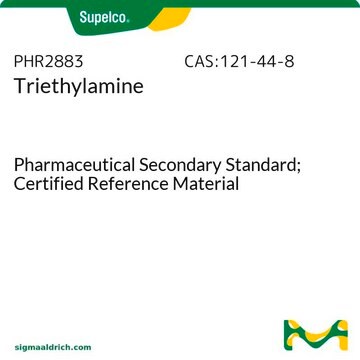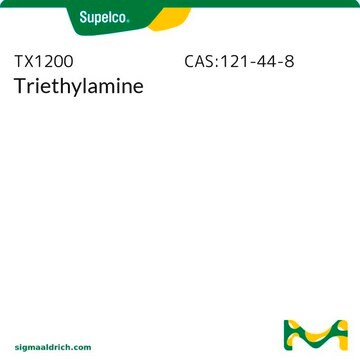73487
Triethylamin
analytical standard
Synonym(e):
N,N-Diethylethanamin
About This Item
Empfohlene Produkte
Qualität
analytical standard
Qualitätsniveau
Dampfdichte
3.5 (vs air)
Dampfdruck
51.75 mmHg ( 20 °C)
Assay
≥99.5% (GC)
Selbstzündungstemp.
593 °F
Haltbarkeit
limited shelf life, expiry date on the label
Expl.-Gr.
8 %
Methode(n)
HPLC: suitable
gas chromatography (GC): suitable
Verunreinigungen
≤0.5% water
Brechungsindex
n20/D 1.400-1.402
n20/D 1.401 (lit.)
bp
88.8 °C (lit.)
mp (Schmelzpunkt)
−115 °C (lit.)
Dichte
0.726 g/mL at 25 °C (lit.)
Anwendung(en)
cleaning products
cosmetics
flavors and fragrances
food and beverages
personal care
Format
neat
SMILES String
CCN(CC)CC
InChI
1S/C6H15N/c1-4-7(5-2)6-3/h4-6H2,1-3H3
InChIKey
ZMANZCXQSJIPKH-UHFFFAOYSA-N
Suchen Sie nach ähnlichen Produkten? Aufrufen Leitfaden zum Produktvergleich
Allgemeine Beschreibung
Anwendung
- Food and beverages using ion-exchange chromatography with conductivity detection.
- Smoke flavoring from rice husk using gas chromatography coupled to mass spectrometric detection, flame ionization detection and olfactometry analysis (GC-O).
Signalwort
Danger
Gefahreneinstufungen
Acute Tox. 3 Dermal - Acute Tox. 3 Inhalation - Acute Tox. 4 Oral - Eye Dam. 1 - Flam. Liq. 2 - Skin Corr. 1A - STOT SE 3
Zielorgane
Respiratory system
Lagerklassenschlüssel
3 - Flammable liquids
WGK
WGK 1
Flammpunkt (°F)
12.2 °F - closed cup
Flammpunkt (°C)
-11 °C - closed cup
Hier finden Sie alle aktuellen Versionen:
Besitzen Sie dieses Produkt bereits?
In der Dokumentenbibliothek finden Sie die Dokumentation zu den Produkten, die Sie kürzlich erworben haben.
Kunden haben sich ebenfalls angesehen
Unser Team von Wissenschaftlern verfügt über Erfahrung in allen Forschungsbereichen einschließlich Life Science, Materialwissenschaften, chemischer Synthese, Chromatographie, Analytik und vielen mehr..
Setzen Sie sich mit dem technischen Dienst in Verbindung.











